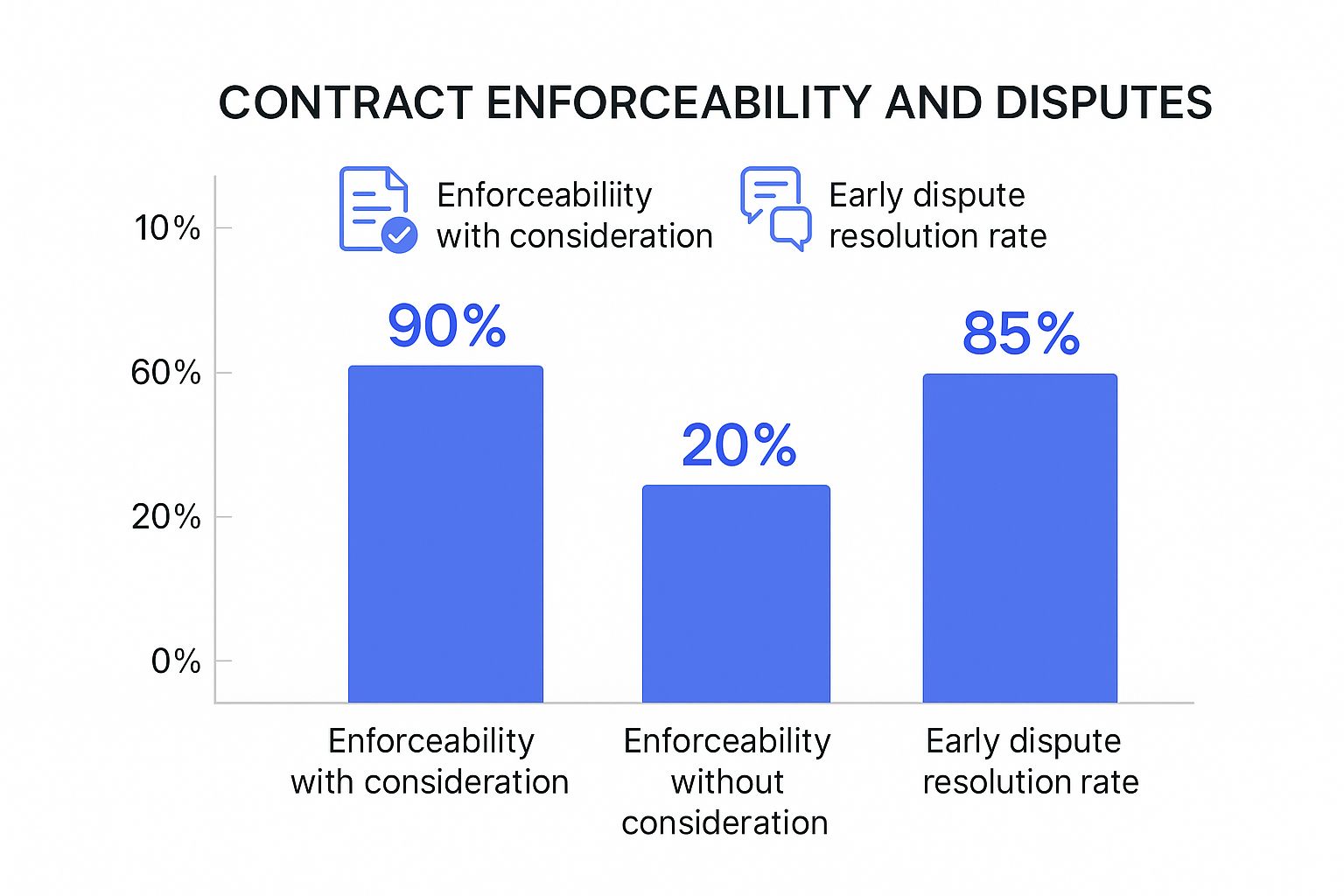
In the simplest terms, consideration is the value each party agrees to give up when they enter a contract. You can think of it as the "price" someone pays for a promise, which is what turns a casual chat into a legally binding deal. It’s the critical ingredient that makes a contract a two-way street instead of a one-sided gift.
The Role of Consideration in Contracts

At its heart, a contract isn't just a document; it's a mutual exchange of promises. Consideration is what fuels this exchange, making sure both sides have some skin in the game. Without it, you’re left with an empty promise that a court will almost certainly refuse to enforce.
Let's say you agree to sell your old laptop for $200. The two sides of consideration are crystal clear:
- Your consideration: The laptop you promise to give the buyer.
- The buyer's consideration: The $200 they promise to pay you.
This mutual trade—your laptop for their cash—is what a court sees as a valid agreement. This whole idea has deep legal roots, dating all the way back to English common law in the 1700s. It was created to draw a sharp line between serious business deals and casual promises made in a social setting.
Why This Exchange of Value Matters
Let's be blunt: the legal system doesn't want to get involved in enforcing one-sided promises or gifts. Requiring consideration ensures that contracts are created deliberately and with clear intent. When both parties stand to gain something and give something up, it signals a genuine commitment to the deal.
A contract is fundamentally a bargained-for exchange. Consideration is the proof of that bargain, showing that the promises weren't just made lightly or by accident. It’s what gives a mutual commitment its legal weight.
This principle is also a safeguard. It protects people from being held to casual remarks or generous offers they made without expecting anything in return. For an agreement to have real legal teeth, each person must bring something of value to the table, even if that "value" isn't cold, hard cash.
Core Components of Legal Consideration
For consideration to be legally valid, it needs to have a few key ingredients. It’s not just about swapping any two things; there are specific elements a court looks for to confirm a real bargain was made.
The table below breaks down these essential components.
| Component | Description | Simple Example |
|---|---|---|
| Bargained-For Exchange | Each party's promise must be made in exchange for the other party's promise. It's a direct trade. | I'll paint your fence if you pay me $500. The painting and the payment are directly linked. |
| Legal Value | What is exchanged must have legal value. This can be a benefit to one party or a detriment (giving something up) to the other. | You give up $500 (a detriment), and I gain $500 (a benefit). I give up my time and paint (a detriment). |
| Mutual Obligation | Both parties must be bound to perform. If one party can back out without any consequence, the contract may be illusory. | Both parties are locked in. I must paint the fence, and you must pay. Neither can walk away freely. |
Understanding these components is the first step to seeing why some agreements hold up in court while others fall apart.
What Actually Counts as "Value"?
While money is the go-to example, the concept of consideration is much broader. Legal value can be almost anything one party isn't already required to provide.
This could be a promise to perform a service (like web design), deliver goods (like furniture), or even a promise not to do something. This last one is called forbearance. For example, promising not to build a structure that blocks your neighbor's view in exchange for a payment is valid consideration.
The key is that each party’s promise must motivate the other party to make their own promise. This creates a web of interconnected obligations, which is the foundation of how all contracts work, from buying a coffee to signing a multi-million dollar merger. You can see how this plays out on a larger scale by reading about the global economic outlook and its impact on contractual exchanges.
The Pillars of Valid Consideration
For a promise to have any real teeth in the eyes of the law, it needs to be backed up by something called valid consideration. The best way to think about it is like a three-legged stool—if you kick out any one of the legs, the whole thing topples over. A contract without all three pillars of consideration is just as unstable.
Getting a handle on these pillars is essential for anyone putting together an agreement. It's the difference between a legally binding contract and a casual promise someone can walk away from without consequences. Let's break down what courts look for.
The Bargained-For Exchange
First up, and arguably the most important, is the bargained-for exchange. This doesn't mean you have to haggle over every last detail like you're at a flea market. It simply means that each party's promise is what motivates the other party to make their promise. It's an intentional "I'll do this if you do that" trade.
In other words, your promise to do something has to be the very reason the other person agrees to their part of the deal, and their promise has to be the reason for yours. The two are directly linked.
A classic example is hiring someone to paint your office for $1,000. Your promise to pay is what gets them to promise to show up with brushes and paint. Their promise to paint is what gets you to promise the money. That mutual inducement is the core of the exchange. Without it, you might just have a promise to give a gift, which isn't a contract at all.
Legal Value and Legal Detriment
The second pillar is legal value. This concept trips a lot of people up because it has almost nothing to do with the actual monetary or "fair market" price of what's being swapped. Instead, legal value exists when someone either does something they weren't legally required to do or gives up the right to do something they legally could.
This action—or lack of action—is known as a legal detriment.
Think about it in these two ways:
- Doing something you aren't obligated to do: You agree to pay a freelance designer to create a new logo for your website. You had no prior legal duty to pay that specific person, so your payment has legal value.
- Giving up something you have a right to do: Your uncle promises to give you $5,000 if you agree not to smoke until you turn 25. Assuming you're of legal age, you have a right to smoke. Giving up that right is a legal detriment, and it counts as valid consideration for his promise.
What really matters is that an exchange happened, not whether it was a fair one. Courts generally won't save you from a "bad deal" as long as both sides gave something of legal value.
Adequacy of Consideration
The final pillar is adequacy, which gets into the fairness of the bargain. As we just touched on, courts usually don't get involved in whether the deal was even. People are free to make their own arrangements, even if they seem lopsided. A contract to sell a brand new car for just $1 is technically enforceable because a bargained-for exchange with legal value took place.
However, a deal that is wildly one-sided can be a huge red flag. If an agreement is grossly unfair, a court might see it as evidence of a deeper problem, like fraud, duress, or someone taking advantage of the other party. Spotting these kinds of issues early is a crucial part of any good contract risk assessment.
So, while perfect adequacy isn't a strict requirement, making sure a deal is at least somewhat reasonable helps make it feel more legitimate and easier to enforce. When all three pillars are in place, you have a solid foundation for a real, mutual commitment.
Common Forms of Consideration in Real Life

The idea of legal "consideration" isn't just for lawyers arguing in a courtroom. It's something we all engage with every day, forming the quiet foundation of countless agreements. From buying your morning coffee to signing an employment offer, this exchange of value is always in motion.
Getting a handle on its common forms makes it much easier to spot what makes an agreement legally "real."
The most common type is a promise for a promise. This is where both sides commit to doing something in the future. Imagine you hire a freelancer to design a new logo. They promise to deliver the design, and you promise to pay their invoice. Both promises are the consideration, creating a binding contract before any work actually begins.
Another everyday form is a promise for an act. Here, one person’s promise only becomes binding once the other person actually does something. The classic example is putting up a flyer for a lost pet—you promise to pay $100, but that promise isn’t enforceable until someone actually finds and returns your cat. The act of returning the cat is the consideration that locks in your promise.
Forbearance: The Promise Not to Act
One of the most interesting and often overlooked types of consideration is forbearance. This is when someone agrees not to do something they have a legal right to do. The "value" they bring to the table is giving up a right or freedom.
For instance, say a key employee leaves your company. You might offer them a generous severance package in exchange for signing a non-compete agreement.
The employee's consideration is their forbearance—their promise to refrain from starting a competing business for a set period. Your consideration is the severance payment. This promise not to compete has clear value, making the whole agreement enforceable.
Likewise, if a client owes you money and you agree not to sue them for late payment in exchange for an additional fee, your forbearance (not suing) is valid consideration. Understanding these nuances is a huge part of learning how to negotiate contracts effectively and making sure your agreements will hold up.
Executory vs. Executed Consideration
Finally, it helps to understand the timing of the consideration. This brings us to two key distinctions:
- Executory Consideration: This refers to promises that will be performed in the future. When you sign a lease, you promise to pay rent each month, and the landlord promises to provide a place to live. Both sides of the deal are still to be completed.
- Executed Consideration: This is an act that has already been completed by one party in exchange for the other's promise. When you pay a web developer after they've finished building your site, your payment is executed consideration for the work they already delivered.
Once you start seeing these different forms in your daily life—from service agreements to job offers—the concept of consideration becomes much clearer. It’s simply the negotiated value, whether it’s an action, money, or even a promise to do nothing at all, that gives a contract its legal teeth.
Understanding Consideration in Corporate Deals
While "consideration" might sound like a simple concept in everyday contracts, it takes on a whole new level of complexity in the high-stakes world of corporate mergers and acquisitions (M&A). In this arena, the idea of a "bargained-for exchange" scales up dramatically, evolving from a straightforward payment into a sophisticated mix of assets designed to close a multi-million or even billion-dollar deal.
When one company buys another, the "price" it pays is the consideration. But it’s rarely as simple as handing over a briefcase full of cash. Instead, what's offered is often a carefully structured blend of financial instruments.
The Language of Corporate Consideration
In an M&A deal, the type of consideration offered sends powerful signals to the market, investors, and even employees. The decision to pay with cash versus company stock isn't just a financial one—it's a strategic move that broadcasts leadership's confidence in the future of the newly combined company.
- Cash Deals: Offering cash is the ultimate power move. It’s often seen as a sign of strength and provides immediate, certain value to the selling company's shareholders. No ambiguity, just a clear-cut price.
- Stock Deals: Paying with stock is a vote of confidence in the future. The selling shareholders receive equity in the acquiring company, tying both sides to the long-term success of the merged entity. It essentially says, "We believe our combined company will be worth more down the road."
- Hybrid Deals: Many deals use a mix of cash and stock. This approach strikes a balance, offering the security of immediate cash while also giving sellers a stake in future growth.
Consideration in M&A is much more than the purchase price; it’s a strategic tool. The structure of the deal—cash, stock, or a mix—reveals the acquiring company's outlook and shapes the future of the combined business.
At its core, this strategic exchange of value is just a massive-scale version of the same legal principle that makes your morning coffee purchase a valid contract.
Consideration on a Global Scale
The numbers involved in these corporate transactions are staggering, showing just how critical this legal concept is to the global economy. When we talk about consideration in M&A, we're referring to the total value paid to acquire a company, and tracking these figures gives a real-world glimpse into the sheer scale of these exchanges.
For example, global M&A deal values hit approximately $1.49 trillion in just the first half of 2025. The Americas were a huge part of that, accounting for about $908 billion—or 61%—of the total. You can dive deeper into the data and learn about the trends shaping global deals on PwC.com.
All these massive figures boil down to the same foundational requirement: a bargained-for exchange of value. Whether it’s a $5 coffee or a $5 billion corporate takeover, the principle of consideration remains the essential ingredient that makes an agreement legally binding and enforceable.
When a Promise Lacks Consideration
Knowing what qualifies as valid consideration is only half the battle. To really protect yourself and your business, you also have to learn to spot promises that look like contracts but are legally hollow because they lack consideration.
Catching these red flags is critical. It helps you avoid unenforceable agreements and keeps you from relying on commitments that a court won't uphold. These situations can feel like legitimate deals at first glance, but they fail a key legal test.
The Problem with Past Consideration
One of the most common ways a promise falls flat is due to past consideration. This happens when someone makes a promise in return for something that has already been done. Since there was no "bargain"—the action wasn't performed to get the promise—the law usually sees it as an unenforceable gift.
Imagine this: your top employee single-handedly saves a major client account with a brilliant presentation. Overflowing with gratitude, you tell them, "Because of that amazing work last week, I'm giving you a $1,000 bonus next month!"
While it feels like the right thing to do, your promise is probably unenforceable. The heroic work was already finished before you promised the bonus, making it past consideration. Legally, the bonus is just a gift, not part of a new contract. You could technically change your mind without any legal fallout.
Illusory Promises That Offer Nothing
Another trap to watch out for is the illusory promise. This is a statement that sounds like a commitment but, when you look closer, doesn't actually bind the person to do anything at all. These promises are so vague or conditional that they don't create any real obligation.
Here are a few classic examples of illusory promises:
- "I'll buy your excess inventory if I feel like it."
- "We will hire your firm if our budget gets approved."
- "I'll pay you whatever I think is fair when the job is done."
In every case, the person making the promise hasn't actually committed to a specific action. Their performance is left entirely up to them, which means there's no mutual obligation—a must-have for any valid contract. For a deeper look at how to draft clear and enforceable commitments, reviewing various contract clause examples can provide valuable insight.
The Pre-Existing Duty Rule
Finally, there’s the pre-existing duty rule. This rule says that promising to do something you are already legally or contractually obligated to do doesn't count as valid consideration. You can't offer something you already owe as the "price" for a new promise from someone else.
The textbook example involves public servants. You can't promise a firefighter $500 to put out the fire at your house—they already have a pre-existing duty to do just that. Likewise, if a contractor demands more money to finish a job they're already under contract to complete for a fixed price, that change might be unenforceable unless they offer something new in return.
To make this crystal clear, let's look at a few scenarios side-by-side to see what separates a real, binding promise from one that's built on shaky ground.
Valid Consideration vs. Unenforceable Promises
| Scenario | Valid Consideration Example | Unenforceable Promise Example |
|---|---|---|
| New Service | A web developer agrees to build a new website for $5,000. The promise of payment is exchanged for the promise of work. | A friend promises to help you move "if they have time on Saturday." The promise is vague and non-committal. |
| Employee Bonus | A company offers a 10% bonus to any salesperson who exceeds their quarterly target. The future performance is the consideration. | A boss promises an employee a bonus for a project they completed last month. This is past consideration. |
| Construction Work | A contractor agrees to add a deck to a house for an extra $8,000, which was not in the original scope. Both parties give something new. | A plumber demands an extra $200 to finish a job they were already contracted to do for a fixed price. This violates the pre-existing duty rule. |
As you can see, the difference is all in the details. A promise only becomes a contract when there's a genuine, two-way exchange of value.
Understanding these exceptions is just as important as knowing what consideration is. An agreement based on past consideration, an illusory promise, or a pre-existing duty is built on a shaky legal foundation that can easily crumble.
The chart below shows just how much valid consideration matters when it comes to contract enforceability and resolving disputes.

The data speaks for itself: agreements with proper consideration are far more likely to be upheld in court and settled without dragging on.
Frequently Asked Questions About Contract Consideration

Even after you get the hang of the basics, some specific questions always seem to pop up when dealing with contract consideration. Let’s tackle some of the most common ones with direct, practical answers.
The goal here is to bridge the gap between theory and what you’ll actually face in the real world. We'll clear up confusion around fairness, what happens when you change a contract, and why a simple gift promise isn’t a binding deal.
Does Consideration Have to Be Fair or Equal in Value?
No, not really. Courts generally don't get into the business of judging whether a deal is "fair" or not. As long as both sides have exchanged something of legal value, the contract is usually valid—even if one person got a spectacularly bad deal. The law is much more concerned with the existence of a bargain than the quality of it.
But hold on. A wildly lopsided agreement can still be a red flag. While not illegal on its own, it might be used as evidence of bigger problems like fraud, duress (being forced into the deal), or unconscionability, any of which could void the contract. So, while value doesn't need to be equal, a huge imbalance can definitely attract unwanted legal attention.
Is a Promise to Give a Gift Enforceable?
A simple promise to give a gift is not legally enforceable because it's missing consideration entirely.
Think of it this way: a contract is a two-way street, but a gift is a one-way street. It’s just a generous promise made without the “bargained-for exchange” that a contract absolutely needs. For a contract to be real, both people have to give and get something of value.
When someone receives a gift, they aren't giving anything of legal value back. Because that exchange is missing, the promise to give the gift can't be enforced in court if the person changes their mind.
This is a core principle in contract law that separates binding agreements from kind but unenforceable offers.
If We Change a Contract, Does It Need New Consideration?
Under traditional contract law, yes. If you want to modify an existing contract, the change has to be supported by new consideration from both sides to be legally binding. This is a common trip-up that can make your changes completely unenforceable.
For example, say a contractor agrees to finish building your deck a week early. For that promise to be binding, you need to offer something new in return, like a small bonus. Without that fresh exchange, their promise to finish early is just a nice gesture—not a legal obligation.
However, there are some important exceptions. The biggest one applies to contracts for the sale of goods under the Uniform Commercial Code (UCC). The UCC, which governs most commercial sales, allows parties to modify a contract in good faith without any new consideration. This rule makes it much easier for businesses to adapt to changing circumstances on the fly.
Navigating the complexities of contract consideration, modifications, and potential risks can be a major challenge. Legal Document Simplifier uses AI to instantly analyze your agreements, flagging key terms, obligations, and risky clauses in plain English. Stop guessing and start understanding your legal documents with confidence.